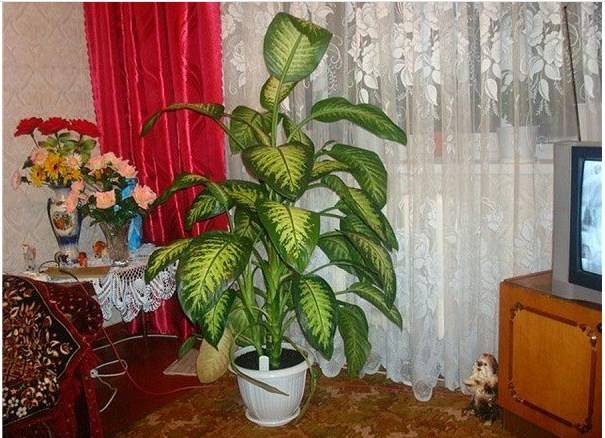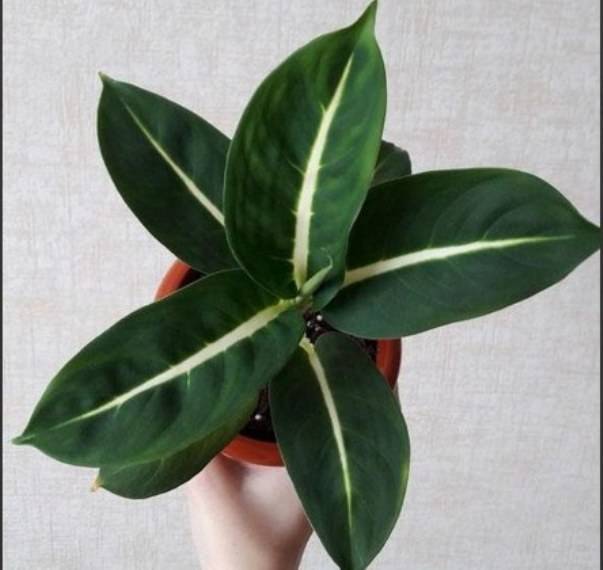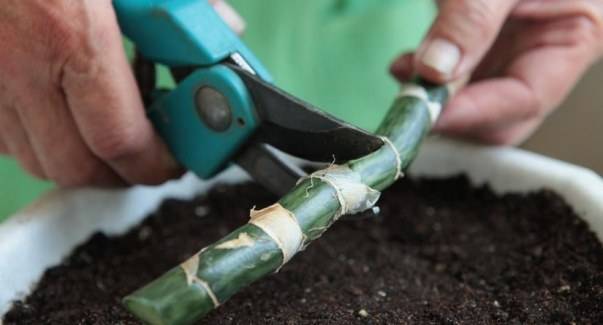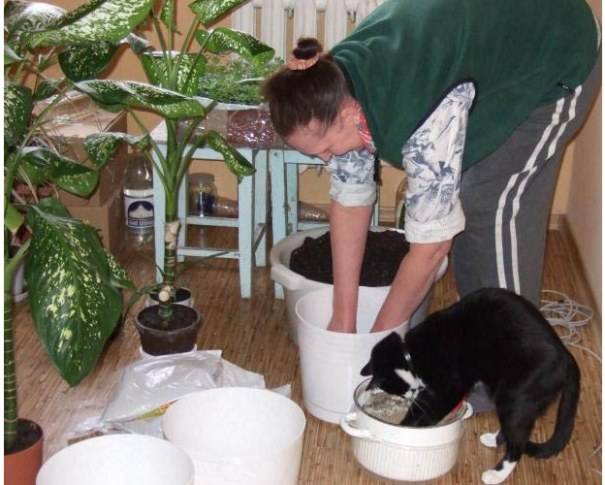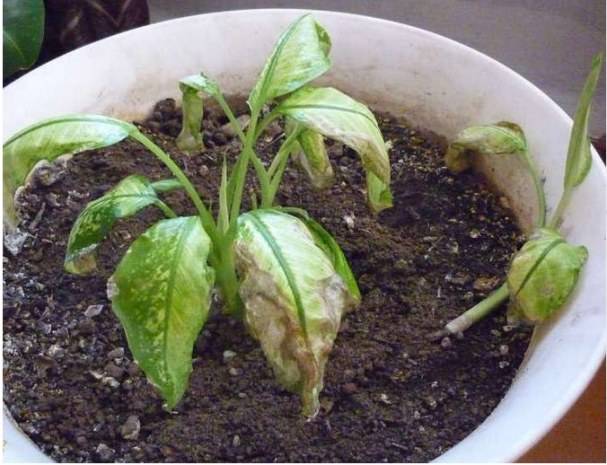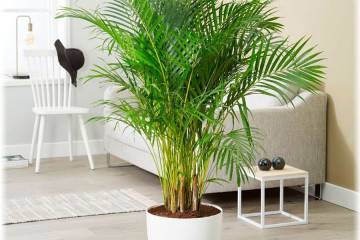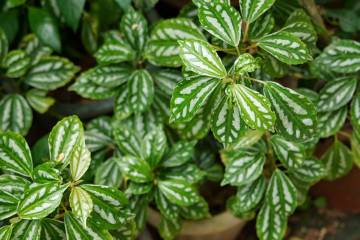Dieffenbachia - home care, reproduction
Content:
Dieffenbachia has taken a strong place among the favorite plants of flower growers. There is no person who has not met this plant at least once in his life. The article describes how to propagate dieffenbachia, the rules for caring for a crop are described.
What does dieffenbachia look like?
An evergreen plant native to the tropics of South America, belongs to the Aroid family. There are 60 varieties, only a few of them are grown at home. General description of the culture - a branching fleshy trunk with oval large spotted leaves growing alternately. Over time, the lower leaves fall off, so the bush takes on an unaesthetic appearance. The plant blooms very rarely. The flower is an ear of small inflorescences, the fruit is a bright red berry.
Common varieties
At home, 10 types of dieffenbachia are grown. The most popular ones are:
- Dieffenbachia Seguina. A powerful plant with large oval leaves that reach 50x35 cm in size. The leafy part has a variegated color that resembles a mix of dark green, light green, white shades. The species does not like bright light. A lack of moisture or an excess of it is the reason why the leaves of dieffenbachia turn yellow.
- Dieffenbachia Oersteda is a bush visible from afar. Draws attention with the bright color of the leaves. They are elongated, brownish-green in color, up to 35 cm long, a white vein is clearly visible in the middle.
- The Bausei variety is a bush up to 90 cm high with a large-leaved variegated crown. The drawing of the leaf part is white-green marble stains, which become lighter when the plant is grown in the sun.
- Dieffenbachia Mix is a compact shrub with an average height of 50 cm. It has a branched shape with a dense crown of variegated leaves. Depending on the place of selection, the coloring of the foliage can be varied. This variety is the most popular in home breeding.
Without proper care, any variety of an unpretentious flower sheds its leaves, the trunk stretches, the color of the crown fades. Before buying a bush, you need to figure out how to care for dieffenbachia.
Caution: the plant is poisonous
The plant contains an enzyme that causes dermatitis and burning of the mucous membranes. You should not put the flowerpot in the children's room. A child or pet can get a throat burn if they taste a dieffenbachia leaf.
Briefly about the history of appearance
For more than 150 years ago, dieffenbachia was actively used for landscaping in European greenhouses; Austrian botanist Josef Dieffenbach carried out reproduction and application in landscape design. The flower was named in honor of the gardener.
Features of dieffenbachia care at home
After dieffenbachia appears in the apartment, home care should create conditions close to natural for her.
Like all tropical plants, Dieffenbachia loves warmth.Temperature drops slow down the growth of the bush and can lead to the death of a green pet. You need to keep the flowerpot in a room with a temperature of at least +18 degrees. The optimal thermal regime is from +20 to +30 degrees.
The flower pot is best placed on the south shaded side. The culture loves good light, in the dark, the leaves can turn yellow, but direct sunlight should not hit the leaves.
The plant is rarely watered, but abundantly. The soil in the pot should dry out between waterings. But you should not leave the plant in a dry substrate for a long time. Drought leads to leaf fall. The water for the bush must be settled, since the culture does not tolerate lime in the composition.
To create optimal conditions for development, the plant should be kept in high humidity. The flower is periodically brought into the bathroom and given a warm shower. To avoid drying out the soil, the pot is placed away from hot batteries. It is useful to carry dieffenbachia on a balcony or terrace in the summer. The crown is sprayed daily with soft water to create the effect of a tropical rain.
The culture loves a light soil that is well ventilated and allows the roots to dry out. In stores, a universal primer is sold with a high percentage of baking powder. The substrate for a moisture-loving flower can be made independently by taking peat, sand and humus in equal proportions.
From March to September, during the period of active growth, the plant is fed once every 2 weeks with mineral fertilizers. In winter, fertilization is stopped. The bush must rest, development in the cold season is very slow.
Features of winter care
Winter is a dormant period for a flower. Starting in October, the shrub is watered less often, feeding is stopped and the temperature of the content is lowered. The pot can be placed closer to the sunny window, since the light intensity is reduced on winter days, the leaves will not get burned.
If dieffenbachia has appeared at home, you need to think about how to prune and transplant in the spring. In winter, the plant is not transplanted, so as not to cause stress in the culture and leaf fall.
Pruning
An adult plant is pruned if it has grown strongly and takes up a lot of indoor space. On a perennial bush, leaves fall from the bottom of the trunk, the crown looks untidy.
Loves preventive flower pruning. When old branches are removed, the tree releases young shoots. Cut old trunks can be grafted for propagation. You can shape the crown, create the outlines of the shrub to your liking. After pruning, the cut at the stems may cry for a while.
How dieffenbachia reproduces
Even a novice florist can cope with the reproduction of dieffenbachia. You should only follow the simple step-by-step agricultural technique.
Speaking about how dieffenbachia reproduces, it is necessary to mention the seeds. It is difficult to get a ripe fruit at home. But if this succeeds, you can try to propagate the plant by sowing method. To do this, the seeds are sown in flat pots on damp ground and cover the container with a film. The container should be kept in a warm place. The greenhouse is opened daily, ventilated and the soil surface is watered. With proper care, seedlings will appear in 14-20 days. After the appearance of several leaves, the seedlings must be planted in separate pots.
Rooting cuttings
Cuttings are cut from the main long trunk or young, but strengthened shoots. The branches are cut into segments with 2-3 internodes, kept for several hours in a root-forming solution. Then they are dropped into the ground in shallow containers and watered as needed.
Non-lignified shoots can be placed in a glass of water for germination. The appearance of the first roots can be expected for several weeks. After the formation of the root part, the sprouts must be planted in the ground.
It is important to remember about the poisonous features of dieffenbachia and carry out planting work with gloves. Cuttings, like other types of reproduction, are carried out in the summer.
Air layering
By studying how dieffenbachia reproduces, growers can use the side branches to propagate the flower. To do this, young shoots are bent to the ground and buried horizontally in the pot of the mother plant. In the future, a sprout will appear from each bud, which can be rooted in a separate flowerpot.
Other options
Old bushes can be propagated with the top of the stem. To do this, cut off the upper part of the plant along with the leaves and put it in water until the first roots appear. The workpiece is planted in a nutrient substrate.
Transfer
The procedure is carried out only in the summer. Renewal mode - 2-4 years. Old bushes about a meter high are difficult to get out of the flowerpot, so only the top layer of the soil is replaced.
Sometimes the bush is transferred to another pot, when the roots of the tree no longer fit in the old one. The new container should be a few centimeters wider. Before transplanting dieffenbachia, a nutrient substrate is prepared, which must be moist. The first few days the plant gets used to the new container, it is not watered, it provides 12 hour daylight hours.
Possible problems in growing Dieffenbachia
The rare flowering of a plant takes away many nutrients from it. This is one of the reasons why dieffenbachia leaves turn yellow. The inflorescence of the culture does not represent aesthetic value; it is recommended to remove it to preserve the bush.
Leaves turn pale
The leafy part may lose color brightness if the flowerpot is in a room with poor lighting. The tree is transferred to a room with good lighting.
Crohn's fades when the soil lacks minerals. We must not forget about fertilizing the plant, periodically apply complex fertilizers.
The tips of the leaves dry
On the leaves of the bush, the tips begin to dry out when there is increased dryness in the room and a lack of moisture in the pot. Care must be taken to spray the crown. So that the edges of the sheets do not turn yellow, they are wiped with a damp cloth from dust, and watering is monitored.
The lower leaves fall
The lower leaves fall off the trunk of the old plant if it requires preventive pruning. The plant gives a signal that nutrients are no longer enough for a large bush. To resuscitate the old bush, dieffenbachia is transplanted into nutrient soil.
Leaves can peel off in rooms with insufficient lighting. For a successful vegetation, the flower needs sunlight in large quantities.
Pests
Pests love to attack the succulent leaves of the plant. Among those who like to eat dieffenbachia juice are aphids, scale insects, worms, spider mites. Their presence can be detected when the yellowing of the crown begins, the leaves may curl. Insects are eliminated with insecticides. In order not to treat the flower, periodically examinations of the stem part and leaves of the bush are carried out.
Other problems
With an excess of moisture in the soil, the stem of the plant begins to rot. To solve the problem, you need to stop watering. Water minimally when the soil in the pot is completely dry. If the roots of the plant were severely affected by a putrefactive disease, the bush can no longer be saved, the top is cut off in order to root it in new soil.
From direct contact with the sun's rays, burns appear on the leaves, the pot is placed away from the window. Low temperatures and drafts lead to shedding of young leaves.
Both an experienced flower grower and a beginner can provide proper care and propagate dieffenbachia at home. Moderate watering, proper lighting, and preventive pruning can help create a small corner of the jungle at home.
